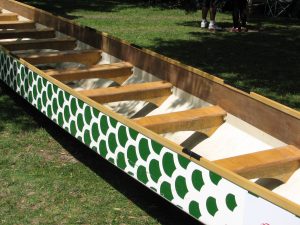Here’s the fourth post in the A-Z Challenge! For the letter “D”, I’m going to talk about one of my favorite hobbies, dragon boat paddling!
I discovered dragon boats in late June 2012. What I thought would be a one-time thing turned out to be a regular activity for me. I joined the local dragon boat team, which has become one of my main social groups here in the Bay Area. So, what exactly is a dragon boat? How did the sport get started? How do you paddle? What are the races like? Keep reading!
What is a Dragon Boat?

A dragon boat is a long, narrow, human-powered racing boat. It’s like an 18-person canoe. The outside of the boat is often painted with a design that looks like dragon scales. During races, a dragon head and tail are attached to the front and back of the boat, respectively.
WHAT IS A DRAGON BOAT Crew Like?
 Dragon boat crews consist of up to 20 paddlers in rows of two. The paddlers in the first row are called the lead strokers and they set the pace. The rest of the paddlers must sync their strokes with those of the lead stroker. Timing is super important, so everyone needs to paddle in unison.
Dragon boat crews consist of up to 20 paddlers in rows of two. The paddlers in the first row are called the lead strokers and they set the pace. The rest of the paddlers must sync their strokes with those of the lead stroker. Timing is super important, so everyone needs to paddle in unison.
The steersperson is in the back of the boat, standing up. This person is responsible for navigating the boat, because the paddlers are busy watching the lead strokers. The steersperson calls out commands to the paddlers to start and stop the boat. He or she is ultimately responsible for the safety of everyone on board.
During the races, a drummer is required. He or she sits at the front of the boat, riding backward facing the paddlers. The drummer beats on a drum in time with the stroke. This helps paddlers stay synchronized. Ideally the drummer should beat in time with the lead strokers.
Paddles
Paddles are what we use to move the boat. 🙂 They can be either wood or lightweight carbon-composite. Paddles come in various lengths. The length of paddle you get depends on your height.
Technique
Many people confuse “paddling” with “rowing”. They’re not the same thing! Rowing involves moving backward through the water. Paddling involves moving forward. We paddle a dragon boat, so yes, we’re moving forward. Somewhat similar sports include kayaking, canoeing, stand-up paddling, and outrigger canoeing.
Beginners can approximate the dragon boat stroke, but with continued practice, anyone can refine their technique and power. Each team has a slightly different approach to the stroke, but the basics are the same.
If you do the stroke correctly, your body should rotate, and your legs, core, and lower back should do most of the work. If you rely too much on your arms and shoulders, you will tire out very quickly. So it’s primarily a core exercise.
Here’s a video of our team during one of our practices. You might spot me in it. 🙂
What are the races like?
Dragon boat races happen throughout the race season. They are usually all-day events, starting early in the morning and wrapping up around mid- to late-afternoon. Teams show up at the race site and set up tents. In between races, people hang out under their team’s tent, eating food (usually potluck) and socializing with fellow teammates.
The race courses are typically either 250 meters or 500 meters long, and individual races are done as “heats”. The overall atmosphere at the races is friendly and festive. Some races are small, with only local teams. Other races are much larger, with teams coming from other states and countries.
What’s the History of Dragon Boating?
Dragon boating originated in China, over 2000 years ago. According to legend: a poet drowned himself in protest against a corrupt government, in the 3rd century B.C. Local fishers tried to save him, in dragon boats. They beat drums to scare fish and threw rice paddies in the river to draw them away from the poet. An annual dragon boat festival was started to reenact the event. This eventually led to modern dragon boat racing. Originally the sport was more of a religious practice associated with the mythical aspects of dragons.

Sounds like a lot of fun but exhausting 😉
Yes, both are accurate observations! 🙂 it can be very exhausting!